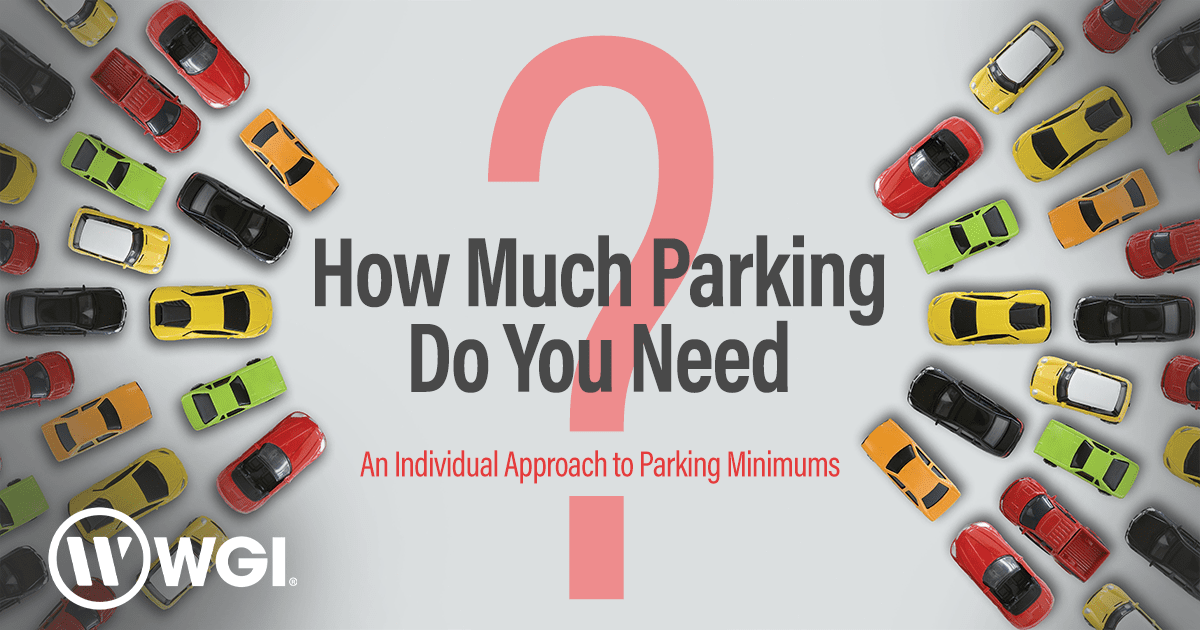By Rob McConnell, PE, SE, LEED Green Associate
An Individual Approach to Parking Minimums
PARKING MINIMUMS were first introduced in 1923 by the City of Columbus, Ohio, and since the post-war boom of the 1950s, they have been a fundamental principle of urban planning across the United States. The idea was to ensure that the parking requirements of new developments could be met within those developments without impacting nearby curbside spaces. Published in the Institute of Transportation Engineers Parking Generation and codified in most zoning ordinances, minimum parking requirements vary for different uses: residential developments often require one to two spaces per unit; retail and commercial usually have ratios based on gross floor area; and restaurants may be based on area or number of tables. Hospitals and churches must satisfy local zoning requirements to ensure they don’t overwhelm local parking supplies.
Parking minimums have long been a bone of contention for developers. They complain that the requirements can be onerous, leaving their developments with scores of unused parking spaces and unnecessarily driving up the cost of their projects. Considering that the national median construction cost is $29,000 for each structured parking space and twice that amount for underground parking, it’s easy to see why developers push back. And it’s not just the cost that’s at issue. Parking is very space intensive, and land that’s required for parking can’t be used to serve the development’s primary function. In some dense urban infill developments, structured parking and even automated mechanical are not even physically practical.
Recently, it has also become popular in some academic and urban planning circles to blame abundant parking for promoting car ownership, urban sprawl, and associated traffic congestion and pollution. Some anti-parking pundits call for removing cars from downtown by creating car-free urban cores. Fast Company magazine referred to this movement as “the car-free revolution.”
Since the publication of Donald Shoup’s The High Cost of Free Parking in 2005, there has been increasing talk about eliminating parking minimums. Some cities are either reducing parking minimums or eliminating them to incentivize more development in their urban cores. In fact, approximately 200 communities have already reduced or eliminated parking requirements, including Buffalo, New York City, Portland, San Francisco, Seattle, and San Diego.
This approach is far from universal, however. Americans are extraordinarily reliant on their cars. According to Statista’s Global Consumer Survey, three out of every four Americans use their own vehicles to get to and from work. Only one in ten use public transportation. While it’s certainly a worthwhile goal to promote mass transit and alternative modes of mobility, planners and leaders must still implement parking plans that accommodate the vehicles that travel to and from their cities daily. In fact, to better meet the needs of visitors and residents, some cities have reversed course from the parking elimination trend, including South Boston, which increased their parking requirements in 2016, and Miami, which reinstated theirs last year.
Why It Matters
When determining how much parking a development needs, developers and city planners must balance and right-size parking. As stated earlier, excessive parking requirements can unnecessarily cost developers much money to create underutilized spaces. Not only can this adversely impact the overall project by reducing the amount of space available for its primary purpose, but it also adds maintenance and life-cycle costs that can be challenging to offset with parking revenues.
The impact of inadequate parking requirements on communities can be just as problematic. Contrary to what some pundits say, cities don’t reduce parking demand by reducing parking supply. Instead, when cities permit the development of projects with inadequate parking, they create additional stress on existing parking supplies. When workers at new commercial or retail developments or residents of new housing projects aren’t provided adequate parking, they are forced to look for parking elsewhere, usually on local streets or in nearby parking facilities. This causes congestion on local streets and pollution as drivers fruitlessly search for on-street spaces. In addition to inconveniencing residents, this can also undermine public safety if it impacts first responders trying to get to an emergency. The additional demand also drives up parking rates in area lots and garages. When there’s more competition for a finite number of parking spaces, prices will inevitably increase. This places an additional burden on area residents and employees of local businesses.

Market Driven
Why are some cities eliminating parking minimums while others are increasing them? Every community is different, with its own unique needs and opportunities. A city with a robust public transit system or a history of micro-mobility adoption may need less parking than one in which vehicle commuting is the predominant means of transportation.
Ideally, the free market should determine the right vehicle accommodation and development mix. Every developer wants a financially successful project, which requires the right mix of amenities, including parking. The perception of insufficient parking, excessive traffic cruising the blocks, or expensive parking drives customers away. Banks and other lenders also play an important role because they are unlikely to fund new developments with insufficient parking. Development financing is predicated on having a marketable, competitive product, and, in most places in the US, this means providing some amount of parking.
How do you figure out how much parking is needed? Certainly, a parking consultant can help by evaluating current parking needs and anticipated growth in those needs. A parking consultant can also identify opportunities for reasonable parking reductions based on shared use, alternative transportation modes in play, and other transportation demand management strategies.
At face value, eliminating parking minimums should allow the free market to dictate the necessary amount of parking. It’s not always that simple, however. Public-private projects, where private developers are backed by public money, may not have the input of private lenders. Publicly funded projects may be guided by social policy or other non-market-driven goals.
Affordable housing is one building type at the center of the current debate. By minimizing or altogether eliminating parking, the developer can use the savings to build more housing units, which serves a public benefit. Given the subsidized nature of the development, there is little risk to the developer in doing so. There are, however, unintended consequences.
In most cities, in-town residents need a car to get to work, go shopping, visit friends and family, and find entertainment. Sure, it’s less of an issue in cities in very dense urban areas with good public transit, but these are the exception, not the rule. This is a particularly important issue in neighborhoods located in larger cities. Many urban areas are “food deserts” with no grocery stores. In these communities, residents must have access to a car just to get food for their families.
People with disabilities can also be significantly impacted when parking minimums are eliminated. Is it reasonable to ask someone with mobility challenges to park several blocks from their residence or walk up to a half mile to a transit station? Likewise, is it fair to people with disabilities who already live or work in the neighborhood to share often insufficient supplies of ADA parking spaces with people who should be parking in that development?
For these reasons, applying (or not requiring) parking minimums must be balanced and fair. As planners, we must operate on the assumption that most people in a given community have a car or other personal vehicle. Limiting the availability of parking spaces doesn’t reduce the number of vehicles needing to park in the area; it just increases competition for those limited spaces and, ultimately, their cost.
There are better ways to manage parking demand while reducing the amount of land required to accommodate that demand—shared parking, for instance. Most zoning codes allow some amount of shared parking. So, for instance, if a church is being developed in a neighborhood, it can partner with another local entity with complementary parking needs, such as an office building. The church will primarily need access to parking on weekends, while the office will need it during the week. Rather than develop separate parking for each, the two can share the same parking facility. There are numerous examples of entities that can share parking in this way.
Parking management and enforcement are also essential. When parking minimums are reduced or eliminated, cities must be prepared for additional cars occupying on-street spaces for extended periods of time. When long-term parking occurs on-street rather than off-street, the convenient parking spaces that local businesses need for their customers aren’t available, driving them elsewhere. The city ends up hurting its local businesses and, consequently, losing tax revenue.
Cities must implement planning approaches encouraging space turnover, such as parking time limits and targeted pricing strategies. Of course, this strategy doesn’t work without adequate enforcement.
Targeted Strategies
Reducing or eliminating parking minimums isn’t necessarily bad, but city leaders and planners must know the risks. In most cities, new developments without parking will inevitably force residents or visitors to the new development into local garages and lots or onto local streets to find parking. This will almost certainly drive up the cost of parking in the area, intensify congestion on the local streets and surrounding neighborhoods, and could have other unintended consequences.
Ultimately, every community presents unique challenges and opportunities that must be addressed individually by cities and their parking consultants. Some cities have sufficient parking resources to handle additional vehicles and can benefit from reducing parking minimums by promoting the use of public transportation, providing land for green space, or achieving other public policy goals. Others, though, will be adversely affected by congestion and rising costs. The best solution will be targeted at addressing the unique situation facing individual communities.
Rob McConnell, PE, SE, LEED Green Associate
Rob McConnell is Vice President at WGI Parking Solutions and a member of IPMI’s Planning, Design, & Construction Committee.
To access the original article, please click here.
Still Have Questions? Don’t Sweat It!
We encourage you to Contact Our Team of experienced Parking Solutions professionals today to discuss the ideal parking strategy to address your city’s unique challenges and opportunities!




















